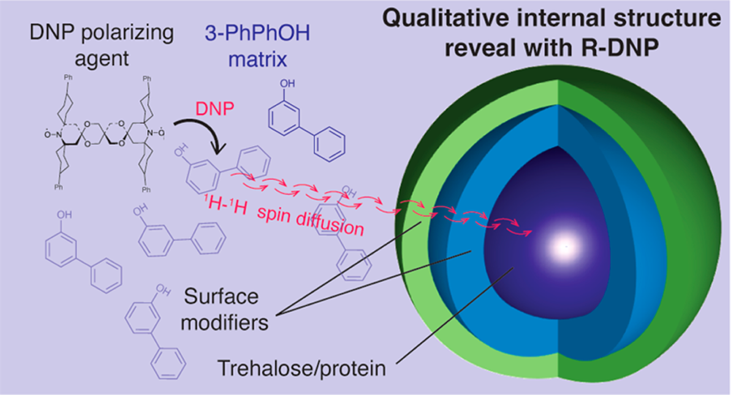Challenge: Formulating protein-based drugs for inhalation poses significant challenges, including ensuring the long-term stability of the protein and optimizing the aerosol properties of the drug. Understanding the internal structure of multicomponent formulations is essential to ensure their efficacy, but traditional methods struggle to provide the necessary level of detail.
NMR Solution: By applying DNP-enhanced solid-state NMR spectroscopy, academic researchers in collaboration with AstraZeneca were able to map the internal structure of complex spray-dried drug formulations. This advanced technique revealed that the protein and trehalose form a single phase in the core of the particles, while the amino acids leucine and trileucine are distributed in layers at the surface. The precise identification of this hierarchy of components enables a better understanding of how these formulations behave, particularly in terms of their dispersibility and aerosolization properties.
Impact: The ability to determine the molecular structure of protein-based drug formulations provides critical insights for rationalizing and optimizing pharmaceutical formulations. This novel application of DNP-enhanced NMR offers a powerful approach to improve inhalable drug delivery systems, ensuring better performance and stability for protein-based drugs. By understanding how components are structured within particles, the pharmaceutical industry can develop more effective and reliable formulations for inhalation therapies, helping to meet the growing demand for these cutting-edge medications.
Key Points for industry:
- Improved Inhalable Formulations: Detailed insight into the internal structure of protein-based drug formulations enable better aerosol properties and stability.
- Advanced NMR Technology: DNP-enhanced NMR allows for the precise characterization of multicomponent formulations, supporting more efficient drug development.
- Optimized Drug Performance: By understanding the layering of amino acids and their effects on dispersibility, more effective inhalable therapies can be created.
Reference: Berruyer, P.; Lindkvist, M.; Gracin, S.; Starciuc, T.; Bertarello, A.; Busi, B.; Schantz, S.; Emsley, L. Hierarchy of the Components in Spray-Dried, Protein-Excipient Particles Using DNP-Enhanced NMR Spectroscopy. Mol. Pharmaceutics 2023, 20, 5682–5689.
https://doi.org/10.1021/acs.molpharmaceut.3c00539

Figure: DNP solid-state NMR spectroscopy was applied to determine the hierarchy of components within spray-dried particles containing protein, trehalose, leucine, and trileucine. Reprinted from Berruyer et al, Mol. Pharmaceutics 2023, 20, 5682–5689.
Licensed under Creative Commons Attribution 4.0 International License (CC BY 4.0).





